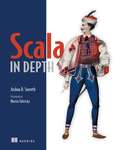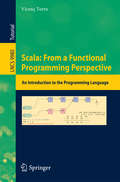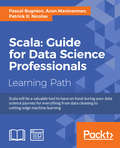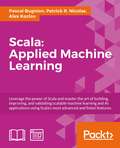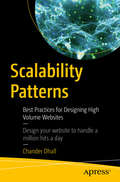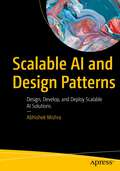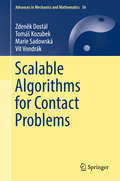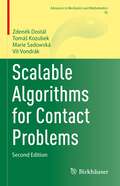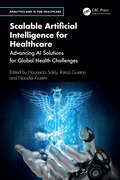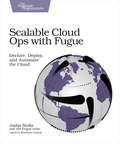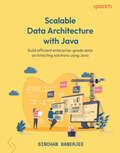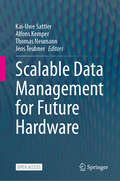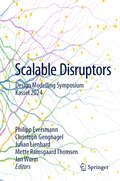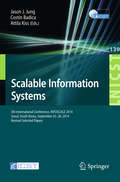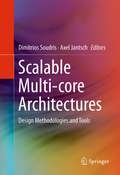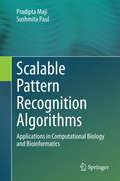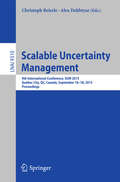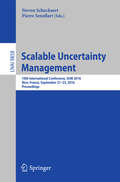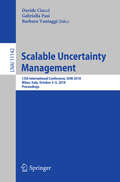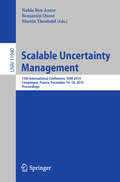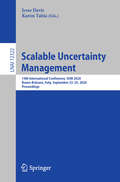- Table View
- List View
Scala in Depth
by Josh SuerethSummaryScala in Depth is a unique new book designed to help you integrate Scala effectively into your development process. By presenting the emerging best practices and designs from the Scala community, it guides you through dozens of powerful techniques example by example.About the BookScala is a powerful JVM language that blends the functional and OO programming models. You'll have no trouble getting introductions to Scala in books or online, but it's hard to find great examples and insights from experienced practitioners. You'll find them in Scala in Depth.There's little heavy-handed theory here—just dozens of crisp, practical techniques for coding in Scala. Written for readers who know Java, Scala, or another OO language. Purchase of the print book comes with an offer of a free PDF, ePub, and Kindle eBook from Manning. Also available is all code from the book. What's InsideConcise, expressive, and readable code styleHow to integrate Scala into your existing Java projectsScala's 2.8.0 collections APIHow to use actors for concurrent programmingMastering the Scala type systemScala's OO features—type member inheritance, multiple inheritance, and compositionFunctional concepts and patterns—immutability, applicative functors, and monads==================================================Table of ContentsScala—a blended languageThe core rulesModicum of style—coding conventionsUtilizing object orientationUsing implicits to write expressive codeThe type systemUsing implicits and types togetherUsing the right collectionActorsIntegrating Scala with JavaPatterns in functional programming
Scala: From a Functional Programming Perspective
by Vicenç TorraThis book gives an introduction to the programming language Scala. It presents it from a functional programming perspective. The book explains with detail functional programming and recursivity, and includes chapters on lazy and eager evaluation, streams, higher-order functions (including map, fold, reduce, and aggregate), and algebraic data types. The book also describes the object-oriented aspects of Scala, as they are a fundamental part of the language. In addition, the book includes a chapter on parallelism in Scala, giving an overview of the actor model.
Scala: Guide for Data Science Professionals
by Patrick R. Nicolas Arun Manivannan Pascal BugnionScala will be a valuable tool to have on hand during your data science journey for everything from data cleaning to cutting-edge machine learning About This Book • Build data science and data engineering solutions with ease • An in-depth look at each stage of the data analysis process — from reading and collecting data to distributed analytics • Explore a broad variety of data processing, machine learning, and genetic algorithms through diagrams, mathematical formulations, and source code Who This Book Is For This learning path is perfect for those who are comfortable with Scala programming and now want to enter the field of data science. Some knowledge of statistics is expected. What You Will Learn • Transfer and filter tabular data to extract features for machine learning • Read, clean, transform, and write data to both SQL and NoSQL databases • Create Scala web applications that couple with JavaScript libraries such as D3 to create compelling interactive visualizations • Load data from HDFS and HIVE with ease • Run streaming and graph analytics in Spark for exploratory analysis • Bundle and scale up Spark jobs by deploying them into a variety of cluster managers • Build dynamic workflows for scientific computing • Leverage open source libraries to extract patterns from time series • Master probabilistic models for sequential data In Detail Scala is especially good for analyzing large sets of data as the scale of the task doesn't have any significant impact on performance. Scala's powerful functional libraries can interact with databases and build scalable frameworks — resulting in the creation of robust data pipelines. The first module introduces you to Scala libraries to ingest, store, manipulate, process, and visualize data. Using real world examples, you will learn how to design scalable architecture to process and model data — starting from simple concurrency constructs and progressing to actor systems and Apache Spark. After this, you will also learn how to build interactive visualizations with web frameworks. Once you have become familiar with all the tasks involved in data science, you will explore data analytics with Scala in the second module. You'll see how Scala can be used to make sense of data through easy to follow recipes. You will learn about Bokeh bindings for exploratory data analysis and quintessential machine learning with algorithms with Spark ML library. You'll get a sufficient understanding of Spark streaming, machine learning for streaming data, and Spark graphX. Armed with a firm understanding of data analysis, you will be ready to explore the most cutting-edge aspect of data science — machine learning. The final module teaches you the A to Z of machine learning with Scala. You'll explore Scala for dependency injections and implicits, which are used to write machine learning algorithms. You'll also explore machine learning topics such as clustering, dimentionality reduction, Naive Bayes, Regression models, SVMs, neural networks, and more. This learning path combines some of the best that Packt has to offer into one complete, curated package. It includes content from the following Packt products: • Scala for Data Science, Pascal Bugnion • Scala Data Analysis Cookbook, Arun Manivannan • Scala for Machine Learning, Patrick R. Nicolas Style and approach A complete package with all the information necessary to start building useful data engineering and data science solutions straight away. It contains a diverse set of recipes that cover the full spectrum of interesting data analysis tasks and will help you revolutionize your data analysis skills using Scala.
Scala:Applied Machine Learning
by Patrick R. Nicolas Pascal Bugnion Alex KozlovLeverage the power of Scala and master the art of building, improving, and validating scalable machine learning and AI applications using Scala's most advanced and finest features About This Book • Build functional, type-safe routines to interact with relational and NoSQL databases with the help of the tutorials and examples provided • Leverage your expertise in Scala programming to create and customize your own scalable machine learning algorithms • Experiment with different techniques; evaluate their benefits and limitations using real-world financial applications • Get to know the best practices to incorporate new Big Data machine learning in your data-driven enterprise and gain future scalability and maintainability Who This Book Is For This Learning Path is for engineers and scientists who are familiar with Scala and want to learn how to create, validate, and apply machine learning algorithms. It will also benefit software developers with a background in Scala programming who want to apply machine learning. What You Will Learn • Create Scala web applications that couple with JavaScript libraries such as D3 to create compelling interactive visualizations • Deploy scalable parallel applications using Apache Spark, loading data from HDFS or Hive • Solve big data problems with Scala parallel collections, Akka actors, and Apache Spark clusters • Apply key learning strategies to perform technical analysis of financial markets • Understand the principles of supervised and unsupervised learning in machine learning • Work with unstructured data and serialize it using Kryo, Protobuf, Avro, and AvroParquet • Construct reliable and robust data pipelines and manage data in a data-driven enterprise • Implement scalable model monitoring and alerts with Scala In Detail This Learning Path aims to put the entire world of machine learning with Scala in front of you. Scala for Data Science, the first module in this course, is a tutorial guide that provides tutorials on some of the most common Scala libraries for data science, allowing you to quickly get up to speed building data science and data engineering solutions. The second course, Scala for Machine Learning guides you through the process of building AI applications with diagrams, formal mathematical notation, source code snippets, and useful tips. A review of the Akka framework and Apache Spark clusters concludes the tutorial. The next module, Mastering Scala Machine Learning, is the final step in this course. It will take your knowledge to next level and help you use the knowledge to build advanced applications such as social media mining, intelligent news portals, and more. After a quick refresher on functional programming concepts using REPL, you will see some practical examples of setting up the development environment and tinkering with data. We will then explore working with Spark and MLlib using k-means and decision trees. By the end of this course, you will be a master at Scala machine learning and have enough expertise to be able to build complex machine learning projects using Scala. This Learning Path combines some of the best that Packt has to offer in one complete, curated package. It includes content from the following Packt products: • Scala for Data Science, Pascal Bugnion • Scala for Machine Learning, Patrick Nicolas • Mastering Scala Machine Learning, Alex Kozlov Style and approach A tutorial with complete examples, this course will give you the tools to start building useful data engineering and data science solutions straightaway. This course provides practical examples from the field on how to correctly tackle data analysis problems, particularly for modern Big Data datasets.
Scalability Patterns: Best Practices for Designing High Volume Websites
by Chander DhallIn this book, the CEO of Cazton, Inc. and internationally-acclaimed speaker, Chander Dhall, demonstrates current website design scalability patterns and takes a pragmatic approach to explaining their pros and cons to show you how to select the appropriate pattern for your site. He then tests the patterns by deliberately forcing them to fail and exposing potential flaws before discussing how to design the optimal pattern to match your scale requirements. The author explains the use of polyglot programming and how to match the right patterns to your business needs. He also details several No-SQL patterns and explains the fundamentals of different paradigms of No-SQL by showing complementary strategies of using them along with relational databases to achieve the best results. He also teaches how to make the scalability pattern work with a real-world microservices pattern. With the proliferation of countless electronic devices and the ever growing number of Internet users, the scalability of websites has become an increasingly important challenge. Scalability, even though highly coveted, may not be so easy to achieve. Think that you can't attain responsiveness along with scalability? Chander Dhall will demonstrate that, in fact, they go hand in hand.What You'll LearnArchitect and develop applications so that they are easy to scale. Learn different scaling and partitioning options and the combinations. Learn techniques to speed up responsiveness. Deep dive into caching, column-family databases, document databases, search engines and RDBMS. Learn scalability and responsiveness concepts that are usually ignored.Effectively balance scalability, performance, responsiveness, and availability while minimizing downtime.Who This Book Is ForExecutives (CXOs), software architects , developers, and IT Pros
Scalable AI and Design Patterns: Design, Develop, and Deploy Scalable AI Solutions
by Abhishek MishraUnderstand and apply the design patterns outlined in this book to design, develop, and deploy scalable AI solutions that meet your organization's needs and drive innovation in the era of intelligent automation.This book begins with an overview of scalable AI systems and the importance of design patterns in creating robust intelligent solutions. It covers fundamental concepts and techniques for achieving scalability in AI systems, including data engineering practices and strategies. The book also addresses scalable algorithms, models, infrastructure, and architecture considerations. Additionally, it discusses deployment, productionization, real-time and streaming data, edge computing, governance, and ethics in scalable AI. Real-world case studies and best practices are presented, along with insights into future trends and emerging technologies.The book focuses on scalable AI and design patterns, providing an understanding of the challenges involved in developing AI systems that can handle large amounts of data, complex algorithms, and real-time processing. By exploring scalability, you will be empowered to design and implement AI solutions that can adapt to changing data requirements.What You Will LearnDevelop scalable AI systems that can handle large volumes of data, complex algorithms, and real-time processingKnow the significance of design patterns in creating robust intelligent solutionsUnderstand scalable algorithms and models to handle extensive data and computing requirements and build scalable AI systemsBe aware of the ethical implications of scalable AI systemsWho This Book Is ForAI practitioners, data scientists, and software engineers with intermediate-level AI knowledge and experience
Scalable Algorithms for Contact Problems (Advances in Mechanics and Mathematics #36)
by Tomáš Kozubek Zdeněk Dostál Marie Sadowská Vít VondrákThis book presents a comprehensive and self-contained treatment of the authors’ newly developed scalable algorithms for the solutions of multibody contact problems of linear elasticity. The brand new feature of these algorithms is theoretically supported numerical scalability and parallel scalability demonstrated on problems discretized by billions of degrees of freedom. The theory supports solving multibody frictionless contact problems, contact problems with possibly orthotropic Tresca’s friction, and transient contact problems. It covers BEM discretization, jumping coefficients, floating bodies, mortar non-penetration conditions, etc. The exposition is divided into four parts, the first of which reviews appropriate facets of linear algebra, optimization, and analysis. The most important algorithms and optimality results are presented in the third part of the volume. The presentation is complete, including continuous formulation, discretization, decomposition, optimality results, and numerical experiments. The final part includes extensions to contact shape optimization, plasticity, and HPC implementation. Graduate students and researchers in mechanical engineering, computational engineering, and applied mathematics, will find this book of great value and interest.
Scalable Algorithms for Contact Problems (Advances in Mechanics and Mathematics #36)
by Tomáš Kozubek Zdeněk Dostál Marie Sadowská Vít VondrákThis book presents a comprehensive treatment of recently developed scalable algorithms for solving multibody contact problems of linear elasticity. The brand-new feature of these algorithms is their theoretically supported numerical scalability (i.e., asymptotically linear complexity) and parallel scalability demonstrated in solving problems discretized by billions of degrees of freedom. The theory covers solving multibody frictionless contact problems, contact problems with possibly orthotropic Tresca’s friction, and transient contact problems. In addition, it also covers BEM discretization, treating jumping coefficients, floating bodies, mortar non-penetration conditions, etc. This second edition includes updated content, including a new chapter on hybrid domain decomposition methods for huge contact problems. Furthermore, new sections describe the latest algorithm improvements, e.g., the fast reconstruction of displacements, the adaptive reorthogonalization of dual constraints, and an updated chapter on parallel implementation. Several chapters are extended to give an independent exposition of classical bounds on the spectrum of mass and dual stiffness matrices, a benchmark for Coulomb orthotropic friction, details of discretization, etc. The exposition is divided into four parts, the first of which reviews auxiliary linear algebra, optimization, and analysis. The most important algorithms and optimality results are presented in the third chapter. The presentation includes continuous formulation, discretization, domain decomposition, optimality results, and numerical experiments. The final part contains extensions to contact shape optimization, plasticity, and HPC implementation. Graduate students and researchers in mechanical engineering, computational engineering, and applied mathematics will find this book of great value and interest.
Scalable Artificial Intelligence for Healthcare: Advancing AI Solutions for Global Health Challenges (Analytics and AI for Healthcare)
by Houneida Sakly, Ramzi Guetari, and Naoufel KraiemThis edited volume examines the transformative impact of AI technologies on global healthcare systems, with a focus on enhancing efficiency and accessibility. The content provides a comprehensive exploration of the principles and practices required to scale AI applications in healthcare, addressing areas such as diagnosis, treatment, and patient care.Key topics include data scalability, model deployment, and infrastructure design, highlighting the use of microservices, containerization, cloud computing, and big data technologies in building scalable AI systems. Discussions cover advancements in machine learning models, distributed processing, and transfer learning, alongside critical considerations such as continuous integration, data privacy, and ethics. Real-world case studies depict both the successes and challenges of implementing scalable AI across various healthcare environments, offering valuable insights for future advancements.This volume serves as a practical and theoretical guide for healthcare professionals, AI researchers, and technology enthusiasts seeking to develop or expand on AI-driven healthcare solutions to address global health challenges effectively.
Scalable Cloud Ops with Fugue: Declare, Deploy, and Automate the Cloud
by Josha StellaHarness the promise of the cloud with Fugue, an operating system built for the cloud. Program cloud infrastructure in a fraction of the time it takes with current tools, debug infrastructure at design time, and centralize your change control process. Written by the Fugue development team, this is the definitive resource to scalable cloud operations with Fugue. Cloud computing represents the greatest shift in computing in more than a decade. But the promise of the cloud is unrealized. The cloud isn't just about shedding the physical data center - it's about shedding the data center mindset. Cloud infrastructure can be controlled via API calls. This means we can view it as a giant general-purpose compute - and program it. That's where the Fugue operating system and the Ludwig language come in. They automate the creation, operation, enforcement, and termination of infrastructure in the cloud. This definitive Fugue guide starts with a simple website and moves on to a more robust application with evolving infrastructure needs as you walk through the steps to harnessing the cloud. With Amazon Web Services, launch infrastructure quickly. Debug in design time. Automate deployment and enforcement of your cloud. Centralize your change control process and automate continuous auditing. Rest easy knowing configuration drift, unwanted changes, and infrastructure quality issues are addressed, continuously and automatically. Hands-on chapters lead you through creating this application step by step. If you're a software engineer, architect, DevOps professional, or enterprise team leader using cloud computing for running applications and websites, this book will change the way you view cloud computing. What You Need:An Amazon Web Services (AWS) account and a basic familiarity with the AWS Console.
Scalable Data Analytics with Azure Data Explorer: Modern ways to query, analyze, and perform real-time data analysis on large volumes of data
by Jason Myerscough Arunee SinghchawlaWrite efficient and powerful KQL queries to query and visualize your data and implement best practices to improve KQL execution performanceKey FeaturesApply Azure Data Explorer best practices to manage your data at scale and reduce KQL execution timeDiscover how to query and visualize your data using the powerful KQLManage cluster performance and monthly costs by understanding how to size your ADX cluster correctlyBook DescriptionAzure Data Explorer (ADX) enables developers and data scientists to make data-driven business decisions. This book will help you rapidly explore and query your data at scale and secure your ADX clusters.The book begins by introducing you to ADX, its architecture, core features, and benefits. You'll learn how to securely deploy ADX instances and navigate through the ADX Web UI, cover data ingestion, and discover how to query and visualize your data using the powerful Kusto Query Language (KQL). Next, you'll get to grips with KQL operators and functions to efficiently query and explore your data, as well as perform time series analysis and search for anomalies and trends in your data. As you progress through the chapters, you'll explore advanced ADX topics, including deploying your ADX instances using Infrastructure as Code (IaC). The book also shows you how to manage your cluster performance and monthly ADX costs by handling cluster scaling and data retention periods. Finally, you'll understand how to secure your ADX environment by restricting access with best practices for improving your KQL query performance.By the end of this Azure book, you'll be able to securely deploy your own ADX instance, ingest data from multiple sources, rapidly query your data, and produce reports with KQL and Power BI.What you will learnBecome well-versed with the core features of the Azure Data Explorer architectureDiscover how ADX can help manage your data at scale on AzureGet to grips with deploying your ADX environment and ingesting and analyzing your dataExplore KQL and learn how to query your dataQuery and visualize your data using the ADX UI and Power BIIngest structured and unstructured data types from an array of sourcesUnderstand how to deploy, scale, secure, and manage ADXWho this book is forThis book is for data analysts, data engineers, and data scientists who are responsible for analyzing and querying their team's large volumes of data on Azure. SRE and DevOps engineers who deploy, maintain, and secure infrastructure will also find this book useful. Prior knowledge of Azure and basic data querying will help you to get the most out of this book.
Scalable Data Architecture with Java: Build efficient enterprise-grade data architecting solutions using Java
by Sinchan BanerjeeOrchestrate data architecting solutions using Java and related technologies to evaluate, recommend and present the most suitable solution to leadership and clientsKey FeaturesLearn how to adapt to the ever-evolving data architecture technology landscapeUnderstand how to choose the best suited technology, platform, and architecture to realize effective business valueImplement effective data security and governance principlesBook DescriptionJava architectural patterns and tools help architects to build reliable, scalable, and secure data engineering solutions that collect, manipulate, and publish data.This book will help you make the most of the architecting data solutions available with clear and actionable advice from an expert.You'll start with an overview of data architecture, exploring responsibilities of a Java data architect, and learning about various data formats, data storage, databases, and data application platforms as well as how to choose them. Next, you'll understand how to architect a batch and real-time data processing pipeline. You'll also get to grips with the various Java data processing patterns, before progressing to data security and governance. The later chapters will show you how to publish Data as a Service and how you can architect it. Finally, you'll focus on how to evaluate and recommend an architecture by developing performance benchmarks, estimations, and various decision metrics.By the end of this book, you'll be able to successfully orchestrate data architecture solutions using Java and related technologies as well as to evaluate and present the most suitable solution to your clients.What you will learnAnalyze and use the best data architecture patterns for problemsUnderstand when and how to choose Java tools for a data architectureBuild batch and real-time data engineering solutions using JavaDiscover how to apply security and governance to a solutionMeasure performance, publish benchmarks, and optimize solutionsEvaluate, choose, and present the best architectural alternativesUnderstand how to publish Data as a Service using GraphQL and a REST APIWho this book is forData architects, aspiring data architects, Java developers and anyone who wants to develop or optimize scalable data architecture solutions using Java will find this book useful. A basic understanding of data architecture and Java programming is required to get the best from this book.
Scalable Data Management for Future Hardware
by Kai-Uwe Sattler Thomas Neumann Alfons Kemper Jens TeubnerThis open access book presents the results of the DFG priority program on Scalable Data Management for Future Hardware. It details requirements and solutions of how modern and future hardware architectures can be leveraged to address the challenges in modern data management. The nine chapters of the book present a wide range of data management architectures in conjunction with current hardware developments, often related to applications in data analytics or machine learning. They cover topics such as hardware-accelerated query or event processing on FPGA, GPU, and multicore CPUs, scalable data management in data center networks or on modern memory and storage technologies, and operating system support. This book provides researchers in academia and industry with a comprehensive combination of data management, operating systems, distributed systems and computer architecture issues necessary to address the requirements from practice as well as to propel innovative ideas and challenging research questions.
Scalable Data Streaming with Amazon Kinesis: Design and secure highly available, cost-effective data streaming applications with Amazon Kinesis
by Tarik Makota Brian Maguire Danny Gagne Rajeev ChakrabartiExplore Kinesis managed services such as Kinesis Data Streams, Kinesis Data Analytics, Kinesis Data Firehose, and Kinesis Video Streams with the help of practical use casesKey FeaturesGet well versed with the capabilities of Amazon KinesisExplore the monitoring, scaling, security, and deployment patterns of various Amazon Kinesis servicesLearn how other Amazon Web Services and third-party applications such as Splunk can be used as destinations for Kinesis dataBook DescriptionAmazon Kinesis is a collection of secure, serverless, durable, and highly available purpose-built data streaming services. This data streaming service provides APIs and client SDKs that enable you to produce and consume data at scale. Scalable Data Streaming with Amazon Kinesis begins with a quick overview of the core concepts of data streams, along with the essentials of the AWS Kinesis landscape. You'll then explore the requirements of the use case shown through the book to help you get started and cover the key pain points encountered in the data stream life cycle. As you advance, you'll get to grips with the architectural components of Kinesis, understand how they are configured to build data pipelines, and delve into the applications that connect to them for consumption and processing. You'll also build a Kinesis data pipeline from scratch and learn how to implement and apply practical solutions. Moving on, you'll learn how to configure Kinesis on a cloud platform. Finally, you'll learn how other AWS services can be integrated into Kinesis. These services include Redshift, Dynamo Database, AWS S3, Elastic Search, and third-party applications such as Splunk. By the end of this AWS book, you'll be able to build and deploy your own Kinesis data pipelines with Kinesis Data Streams (KDS), Kinesis Data Firehose (KFH), Kinesis Video Streams (KVS), and Kinesis Data Analytics (KDA).What you will learnGet to grips with data streams, decoupled design, and real-time stream processingUnderstand the properties of KFH that differentiate it from other Kinesis servicesMonitor and scale KDS using CloudWatch metricsSecure KDA with identity and access management (IAM)Deploy KVS as infrastructure as code (IaC)Integrate services such as Redshift, Dynamo Database, and Splunk into KinesisWho this book is forThis book is for solutions architects, developers, system administrators, data engineers, and data scientists looking to evaluate and choose the most performant, secure, scalable, and cost-effective data streaming technology to overcome their data ingestion and processing challenges on AWS. Prior knowledge of cloud architectures on AWS, data streaming technologies, and architectures is expected.
Scalable Disruptors: Design Modelling Symposium Kassel 2024
by Christoph Gengnagel Mette Ramsgaard Thomsen Jan Wurm Philipp Eversmann Julian LienhardThis book reflects and expands on current trends in the Architecture, Engineering and Construction (AEC) industries as they respond to the unfolding climate and biodiversity crisis. Shifting away from the traditional focuses, which are narrowly centered on efficiency, this book presents a variety of approaches to move the AEC community from a linear, extractive paradigm to circular and regenerative one. The book presents contributions including research papers and case studies, providing a comprehensive overview of the field as well as perspectives from related disciplines, such as computer science, biology and material science.
Scalable Information Systems
by Jason J. Jung Costin Badica Attila KissThis book constitutes the thoroughly refereed post-conference proceedings of the International Conference on Scalable Information Systems, INFOSCALE 2014, held in September 2014 in Seoul, South Korea. The 9 revised full papers presented were carefully reviewed and selected from 14 submissions. The papers cover a wide range of topics such as scalable data analysis and big data applications.
Scalable Multi-core Architectures
by Dimitrios Soudris Axel JantschAs Moore's law continues to unfold, two important trends have recently emerged. First, the growth of chip capacity is translated into a corresponding increase of number of cores. Second, the parallelization of the computation and 3D integration technologies lead to distributed memory architectures. This book describes recent research that addresses urgent challenges in many-core architectures and application mapping. It addresses the architectural design of many core chips, memory and data management, power management, design and programming methodologies. It also describes how new techniques have been applied in various industrial case studies.
Scalable Pattern Recognition Algorithms
by Pradipta Maji Sushmita PaulThis book addresses the need for a unified framework describing how soft computing and machine learning techniques can be judiciously formulated and used in building efficient pattern recognition models. The text reviews both established and cutting-edge research, providing a careful balance of theory, algorithms, and applications, with a particular emphasis given to applications in computational biology and bioinformatics. Features: integrates different soft computing and machine learning methodologies with pattern recognition tasks; discusses in detail the integration of different techniques for handling uncertainties in decision-making and efficiently mining large biological datasets; presents a particular emphasis on real-life applications, such as microarray expression datasets and magnetic resonance images; includes numerous examples and experimental results to support the theoretical concepts described; concludes each chapter with directions for future research and a comprehensive bibliography.
Scalable Techniques for Formal Verification
by Sandip RayThis book presents state-of-the-art approaches to formal verification techniques to seamlessly integrate different formal verification methods within a single logical foundation. It should benefit researchers and practitioners looking to get a broad overview of the spectrum of formal verification techniques, as well as approaches to combining such techniques within a single framework. Coverage includes a range of case studies showing how such combination is fruitful in developing a scalable verification methodology for industrial designs. This book outlines both theoretical and practical issues involved in integrating different reasoning methods to work in concert, and current approaches to their resolution.
Scalable Uncertainty Management
by Christoph Beierle Alex DekhtyarThis book constitutes the refereed proceedings of the 9th International Conference on Scalable Uncertainty Management, SUM 2015, held in Québec City, QC, Canada, in September 2015. The 25 regular papers and 3 short papers were carefully reviewed and selected from 49 submissions. The call for papers for SUM 2015 solicited submissions in all areas of managing and reasoning with substantial and complex kinds of uncertain, incomplete or inconsistent information. These include applications in decision support systems, risk analysis, machine learning, belief networks, logics of uncertainty, belief revision and update, argumentation, negotiation technologies, semantic web applications, search engines, ontology systems, information fusion, information retrieval, natural language processing, information extraction, image recognition, vision systems, data and text mining, and the consideration of issues such as provenance, trust, heterogeneity, and complexity of data and knowledge.
Scalable Uncertainty Management
by Steven Schockaert Pierre SenellartThis book constitutes the refereed proceedings of the 10th International Conference on Scalable Uncertainty Management, SUM 2016, held in Nice, France, in September 2016. The 18 regular papers and 5 short papers were carefully reviewed and selected from 35 submissions. Papers are solicited in all areas of managing and reasoning with substantial and complex kinds of uncertain, incomplete or inconsistent information. These include (but are not restricted to) applications in decision support systems, risk analysis, machine learning, belief networks, logics of uncertainty, belief revision and update, argumentation, negotiation technologies, semantic web applications, search engines, ontology systems, information fusion, information retrieval, natural language processing, information extraction, image recognition, vision systems, data and text mining, and the consideration of issues such as provenance, trust, heterogeneity, and complexity of data and knowledge.
Scalable Uncertainty Management: 12th International Conference, SUM 2018, Milan, Italy, October 3-5, 2018, Proceedings (Lecture Notes in Computer Science #11142)
by Davide Ciucci Barbara Vantaggi Gabriella PasiThis book constitutes the refereed proceedings of the 12th International Conference on Scalable Uncertainty Management, SUM 2018, which was held in Milan, Italy, in October 2018. The 23 full, 6 short papers and 2 tutorials presented in this volume were carefully reviewed and selected from 37 submissions. The conference is dedicated to the management of large amounts of complex, uncertain, incomplete, or inconsistent information. New approaches have been developed on imprecise probabilities, fuzzy set theory, rough set theory, ordinal uncertainty representations, or even purely qualitative models.
Scalable Uncertainty Management: 13th International Conference, SUM 2019, Compiègne, France, December 16–18, 2019, Proceedings (Lecture Notes in Computer Science #11940)
by Martin Theobald Nahla Ben Amor Benjamin QuostThis book constitutes the refereed proceedings of the 13th International Conference on Scalable Uncertainty Management, SUM 2019, which was held in Compiègne, France, in December 2019. The 25 full, 4 short, 4 tutorial, 2 invited keynote papers presented in this volume were carefully reviewed and selected from 44 submissions. The conference is dedicated to the management of large amounts of complex, uncertain, incomplete, or inconsistent information. New approaches have been developed on imprecise probabilities, fuzzy set theory, rough set theory, ordinal uncertainty representations, or even purely qualitative models.
Scalable Uncertainty Management: 14th International Conference, SUM 2020, Bozen-Bolzano, Italy, September 23–25, 2020, Proceedings (Lecture Notes in Computer Science #12322)
by Jesse Davis Karim TabiaThis book constitutes the refereed proceedings of the 14th International Conference on Scalable Uncertainty Management, SUM 2020, which was held in Bozen-Bolzano, Italy, in September 2020. The 12 full, 7 short papers presented in this volume were carefully reviewed and selected from 30 submissions. Besides that, the book also contains 2 abstracts of invited talks, 2 tutorial papers, and 2 PhD track papers. The conference aims to gather researchers with a common interest in managing and analyzing imperfect information from a wide range of fields, such as artificial intelligence and machine learning, databases, information retrieval and data mining, the semantic web and risk analysis. Due to the Corona pandemic SUM 2020 was held as an virtual event.
Scalable Uncertainty Management: 15th International Conference, SUM 2022, Paris, France, October 17–19, 2022, Proceedings (Lecture Notes in Computer Science #13562)
by Florence Dupin de Saint-Cyr Meltem Öztürk-Escoffier Nico PotykaThis book constitutes the refereed proceedings of the 15th International Conference on Scalable Uncertainty Management, SUM 2022, which was held in Paris, France, in October 2022.The 19 full and 4 short papers presented in this volume were carefully reviewed and selected from 25 submissions. Besides that, the book also contains 3 abstracts of invited talks and 2 tutorial papers. The conference aims to gather researchers with a common interest in managing and analyzing imperfect information from a wide range of fields, such as artificial intelligence and machine learning, databases, information retrieval and data mining, the semantic web and risk analysis.The chapter "Defining and Enforcing Descriptive Accuracy in Explanations: the Case of Probabilistic Classifiers" is licensed under the terms of the Creative Commons Attribution 4.0 International License.
